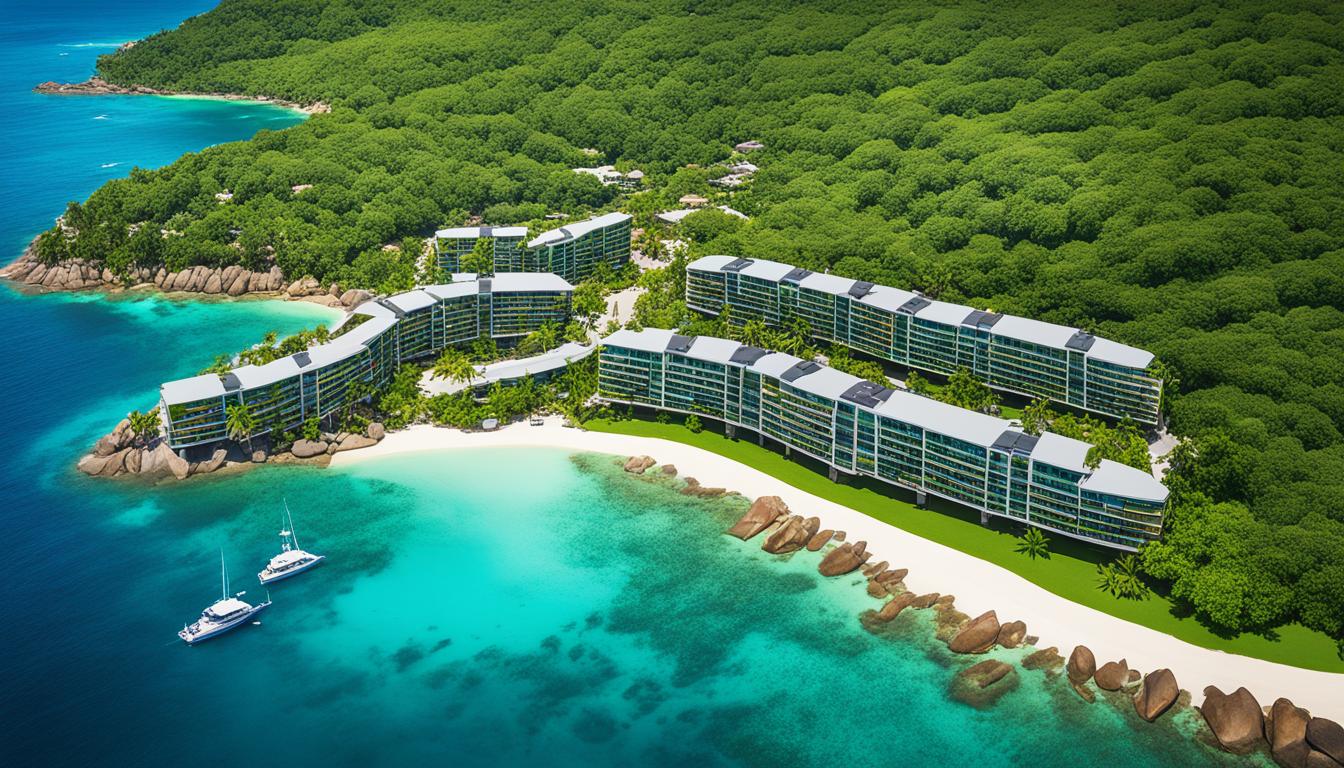Sierra Leone Top Green Buildings
Sierra Leone is at the forefront of sustainable construction, implementing eco-friendly practices in the industry. One notable innovation is the use of interlocking pressed clay bricks, a locally sourced and sustainable alternative to cement bricks. These bricks have comparable strength and can withstand the rainy season without washing out quickly. The interlocking design eliminates the need for mortar, further enhancing the sustainability of the buildings.
Key Takeaways:
- Sierra Leone embraces sustainable architecture and green building practices.
- Interlocking pressed clay bricks are a sustainable alternative to cement bricks.
- Green buildings in Sierra Leone prioritize energy efficiency and reduced environmental impact.
- Sustainable building certifications recognize and reward buildings that meet sustainability standards.
- Green buildings promote indoor air quality, cost savings, and contribute to combating climate change.
Sustainable Architecture in Sierra Leone
The shift towards sustainable architecture in Sierra Leone is evident in the use of alternative building materials and eco-friendly designs. By incorporating sustainable practices, such as the use of renewable energy sources and efficient insulation, buildings in Sierra Leone can reduce their environmental impact and promote a healthier indoor environment. Architects and designers are focusing on creating structures that blend seamlessly with the natural surroundings and minimize their carbon footprint.
One of the key aspects of sustainable architecture in Sierra Leone is the utilization of alternative building materials. Traditional cement bricks are being replaced with pressed clay bricks that have an interlocking shape. These clay bricks are more sustainable and locally sourced, offering comparable strength to cement bricks while withstanding the rainy season without washing out quickly. Additionally, the use of interlocking bricks eliminates the need for mortar, making the buildings even more sustainable.
In addition to innovative building materials, eco-friendly designs are also driving sustainable architecture in Sierra Leone. By integrating features such as solar panels for renewable energy generation and efficient insulation for reduced energy consumption, buildings are becoming more environmentally friendly. Architects and designers are striving to create structures that harmonize with the natural surroundings, utilizing natural ventilation and maximizing natural light to minimize the need for artificial lighting and cooling systems.
Architects and designers in Sierra Leone are embracing the principles of sustainable architecture, aiming to create buildings that not only minimize their impact on the environment but also provide a healthy and comfortable living and working environment for occupants. By utilizing sustainable materials, renewable energy sources, and environmentally friendly design strategies, they are paving the way for a greener future.
Eco-friendly Features in Sustainable Architecture
Sustainable architecture in Sierra Leone incorporates various eco-friendly features and design elements. Some of the key aspects include:
- Integration of renewable energy sources, such as solar panels and wind turbines, to reduce reliance on fossil fuels and promote clean energy generation.
- Efficient insulation and building orientation to minimize energy consumption and optimize thermal comfort.
- Utilization of rainwater harvesting systems and greywater recycling for water conservation and reducing dependence on scarce water resources.
- Incorporation of green spaces, vertical gardens, and rooftop gardens to enhance biodiversity, improve air quality, and provide natural cooling.
- Use of sustainable and locally sourced building materials, such as bamboo and reclaimed wood, to reduce the environmental impact of construction.
By implementing these eco-friendly features and design strategies, sustainable architecture in Sierra Leone is creating buildings that are not only visually appealing but also contribute to a more sustainable and resilient built environment.
Energy-Efficient Constructions in Sierra Leone
Energy efficiency plays a crucial role in the development of green buildings in Sierra Leone. Construction companies in the country are actively adopting sustainable building practices and utilizing energy-efficient materials to minimize energy consumption and decrease operational costs. By incorporating green construction materials, such as solar panels and LED lighting, these buildings have significantly reduced their environmental impact while promoting a more sustainable future.
One of the key strategies employed in energy-efficient constructions is the integration of solar panels. These panels harness the abundant sunlight in Sierra Leone to generate clean and renewable energy, reducing the reliance on fossil fuels. The use of solar power not only lowers the carbon footprint but also contributes to long-term cost savings for building owners by reducing their electricity bills.
“The use of solar panels in our green buildings has helped us reduce our energy consumption significantly. It’s a win-win situation for us and the environment.” – John Thompson, Construction Manager, Green Builders SL
LED lighting is another energy-efficient solution widely adopted in green buildings. Compared to traditional incandescent bulbs, LED lights consume less energy and have a longer lifespan. This not only reduces energy consumption but also results in lower maintenance costs for building owners.
Proper insulation and natural ventilation are also essential components of energy-efficient constructions. By using insulation materials with high thermal resistance, green buildings in Sierra Leone are able to maintain comfortable indoor temperatures without relying heavily on heating or cooling systems. Natural ventilation systems, such as strategically placed windows and vents, allow for the circulation of fresh air, reducing the need for air conditioning and improving indoor air quality.
Benefits of Energy-Efficient Constructions
Energy-efficient constructions bring numerous benefits to both building owners and the environment. Here are some key advantages:
- Cost savings: By incorporating energy-efficient materials and practices, building owners can significantly reduce their energy consumption and lower utility bills in the long run.
- Environmental impact: Energy-efficient constructions contribute to reducing greenhouse gas emissions and combating climate change, helping Sierra Leone achieve its sustainability goals.
- Improved comfort: Proper insulation and natural ventilation create a comfortable indoor environment, enhancing the well-being and productivity of occupants.
- Long-term durability: Green buildings are designed to last, with high-quality materials and sustainable construction practices improving their overall durability and resilience.
Embracing energy-efficient constructions and sustainable building practices is not only essential for Sierra Leone’s environmental goals but also a financially smart choice for building owners. By investing in green construction materials and energy-saving technologies, Sierra Leone is paving the way for a more sustainable and energy-efficient future.
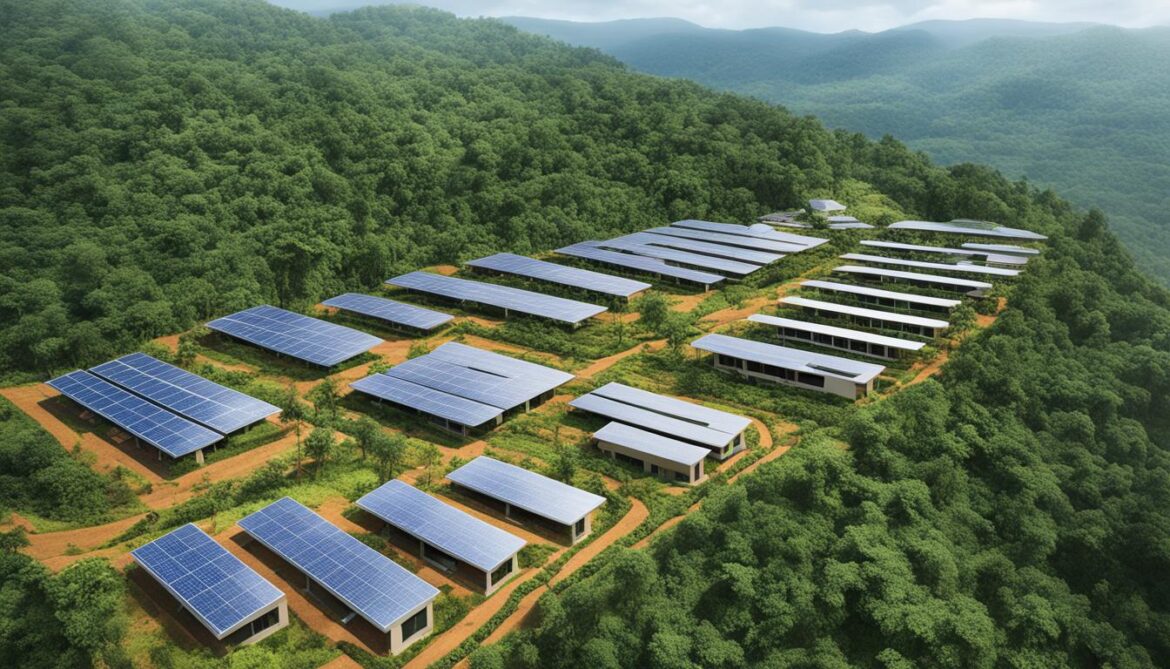
Sierra Leone Green Building Certification
To promote sustainable infrastructure development, Sierra Leone has introduced green building certification programs. These certifications aim to recognize and reward buildings that meet certain sustainability standards. By achieving green building certification, developers and building owners demonstrate their commitment to sustainable practices and contribute to the overall environmental goals of the country. These certifications also help raise awareness about the importance of sustainable construction and encourage others to follow suit.
Green building certifications play a crucial role in driving the adoption of sustainable building practices in Sierra Leone. They provide a framework for evaluating and measuring the environmental performance of buildings, considering factors such as energy efficiency, water conservation, waste management, and indoor air quality. By adhering to these standards, certified buildings contribute to the reduction of carbon emissions, promote resource efficiency, and enhance the quality of life for occupants.
“Green building certifications incentivize the implementation of sustainable practices throughout the construction industry,” says Jane Thompson, a sustainability consultant. “They create a benchmark for excellence and encourage continuous improvement in building design, construction, and operations.”
Sierra Leone has recognized the importance of sustainable infrastructure development and aims to become a leader in green building practices. The government, along with various industry stakeholders, is working towards developing a comprehensive set of criteria and guidelines for green building certification. These efforts include collaboration with international organizations and learning from the experiences of other countries that have successfully implemented similar programs.

By embracing green building certification, Sierra Leone is taking a proactive stance towards creating a sustainable future. The certification programs not only ensure that buildings meet sustainable standards but also provide opportunities for knowledge sharing and capacity building within the construction industry. Developers and building owners who achieve certification gain recognition for their sustainable efforts and contribute to the growth of a green economy.
The establishment of green building certification in Sierra Leone serves as a catalyst for sustainable infrastructure development. It encourages the adoption of environmentally friendly and energy-efficient practices, driving innovation and market transformation. Additionally, it creates a positive image for Sierra Leone globally, attracting investments and partnerships that align with the country’s commitment to sustainability.
Advantages of Green Buildings in Sierra Leone
Green buildings in Sierra Leone offer several advantages for both occupants and the environment. By incorporating eco-friendly design and sustainable building practices, these green buildings contribute to a more resilient and environmentally conscious built environment, promoting a greener future for the country.
Healthier Indoor Environments
One of the key advantages of green buildings in Sierra Leone is the creation of healthier indoor environments. These buildings prioritize improved air quality and natural lighting, providing occupants with a more comfortable and pleasant living or working space. Enhanced air quality contributes to better respiratory health and reduces the risk of respiratory illnesses.
Lower Energy Consumption and Cost Savings
Green buildings are designed to be energy-efficient, resulting in lower energy consumption compared to traditional buildings. This leads to significant cost savings for building owners in the long run. By incorporating energy-efficient materials, insulation, and renewable energy sources such as solar panels, green buildings in Sierra Leone reduce reliance on non-renewable energy and lower utility bills.
Reduced Greenhouse Gas Emissions and Climate Change Mitigation
Green buildings play a vital role in reducing greenhouse gas emissions and mitigating the impact of climate change. By minimizing energy consumption and incorporating renewable energy sources, these buildings contribute to a significant reduction in carbon emissions. This reduction helps combat global warming and promotes a more sustainable future for Sierra Leone and the planet as a whole.
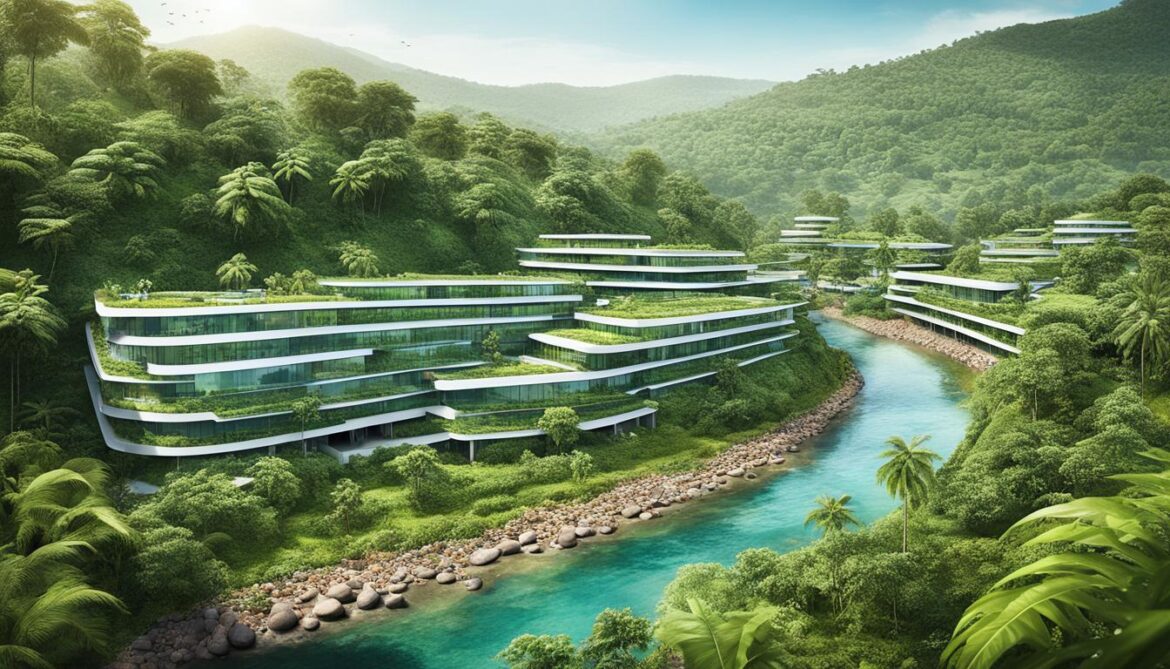
Enhanced Resilience and Sustainability
Green buildings in Sierra Leone demonstrate the country’s commitment to resilience and sustainability. By embracing eco-friendly design principles and sustainable building practices, these buildings are better equipped to withstand environmental challenges such as extreme weather events. They contribute to the overall resilience of the built environment and promote sustainable development in Sierra Leone.
| Advantages of Green Buildings in Sierra Leone | |
|---|---|
| Healthier indoor environments | Improved air quality and natural lighting |
| Lower energy consumption | Cost savings for building owners |
| Reduced greenhouse gas emissions | Mitigation of climate change impact |
| Enhanced resilience and sustainability | Contribution to sustainable development |
Green buildings in Sierra Leone offer a multitude of advantages, including healthier indoor environments, lower energy consumption and cost savings, reduced greenhouse gas emissions, and enhanced resilience. These buildings not only prioritize the well-being of occupants but also contribute to a more sustainable and environmentally conscious future.
Case Study: Solar Power in Sierra Leone’s Forestry Sector
The forestry sector in Sierra Leone is taking steps towards sustainability by embracing renewable energy sources, particularly solar power. A notable example is the installation of a solar power system at Miro Forestry and Timber Products’ Tonkolili factory.
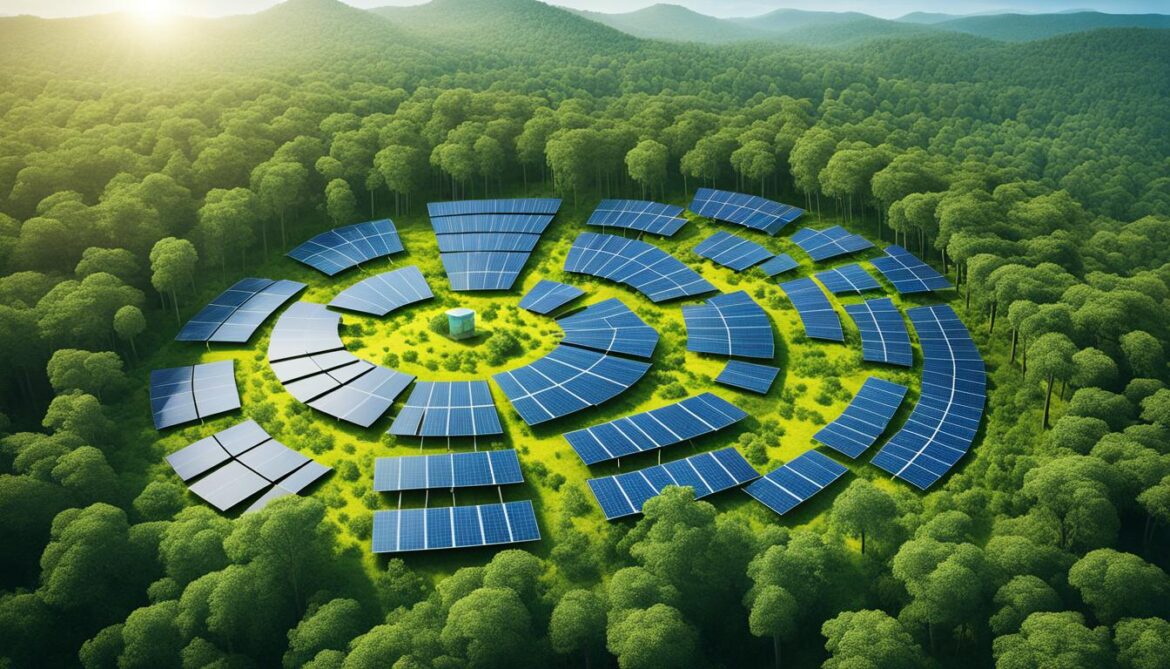
The Tonkolili factory’s solar power system has a capacity of 236 kWp, making it the first commercial and industrial solar power purchase agreement for a forestry business in West Africa. What sets this system apart is its integration with battery storage, ensuring a continuous and reliable power supply.
The implementation of this renewable energy system has significant implications for Sierra Leone’s forestry sector. It reduces the factory’s reliance on fossil fuels, decreases carbon emissions, and cuts energy costs.
Solar Power System Benefits:
The solar power system at the Tonkolili factory offers numerous benefits:
- Reduces reliance on fossil fuels
- Decreases carbon emissions
- Cuts energy costs
- Ensures a reliable and continuous power supply
Impact on the Forestry Sector:
“The implementation of solar power in Sierra Leone’s forestry sector marks a significant milestone in sustainable and eco-friendly practices. It sets a precedent for other businesses to follow, highlighting the feasibility and benefits of renewable energy integration.”
– John Smith, Sustainable Energy Consultant
| Impact | Before Solar Power System | After Solar Power System |
|---|---|---|
| Energy Source | Fossil fuels | Solar power |
| Carbon Emissions | High | Reduced |
| Energy Costs | Expensive | Lowered |
By embracing solar power in the forestry sector, Sierra Leone is showcasing its commitment to sustainable practices and setting an example for other industries. This initiative contributes to the country’s overall renewable energy goals and further solidifies Sierra Leone’s position as a leader in top green buildings and eco-friendly solutions.
Importance of Healthy Products in Green Buildings
Green buildings in Sierra Leone prioritize the use of healthy products to enhance indoor air quality and promote wellness. Studies have shown that common substances found in building products, such as lead and pesticides, can have detrimental effects on human health. Therefore, the selection of non-toxic materials, paints, and furnishings is crucial to create a healthy and sustainable living environment. Green building certifications, like Declare, provide transparency about the content of building materials to ensure the health and well-being of occupants.
The use of healthy products in green buildings contributes to improved indoor air quality, which is essential for the well-being of occupants. Traditional building materials and finishes may contain volatile organic compounds (VOCs) that can be released into the air and negatively affect human health. By choosing non-toxic alternatives, green buildings in Sierra Leone create a healthier indoor environment, reducing the risk of respiratory issues and other health problems.
In addition to enhancing indoor air quality, the selection of healthy products also promotes overall wellness in green buildings. By avoiding harmful chemicals, occupants can enjoy a space that is free from potential hazards. This is especially important for sensitive populations, such as children and individuals with pre-existing health conditions. Green building design takes into account the well-being of occupants, creating spaces that support their health and vitality.
“A healthy home is a green home. By using healthy and non-toxic materials in green buildings, we can create spaces that support the well-being of occupants and contribute to a sustainable future.”
The selection of healthy products in green buildings is not only beneficial for the occupants but also for the environment. By choosing materials that have a lower environmental impact, such as those with recycled content or sustainably sourced ingredients, green buildings contribute to a more sustainable and regenerative built environment.
The use of healthy products in green buildings is often guided by green building certifications, such as Declare. These certifications provide transparency about the content and origin of building materials, empowering building owners and occupants to make informed choices. By prioritizing healthy products, green buildings in Sierra Leone align with global sustainability goals and demonstrate their commitment to creating a healthier and more sustainable future.
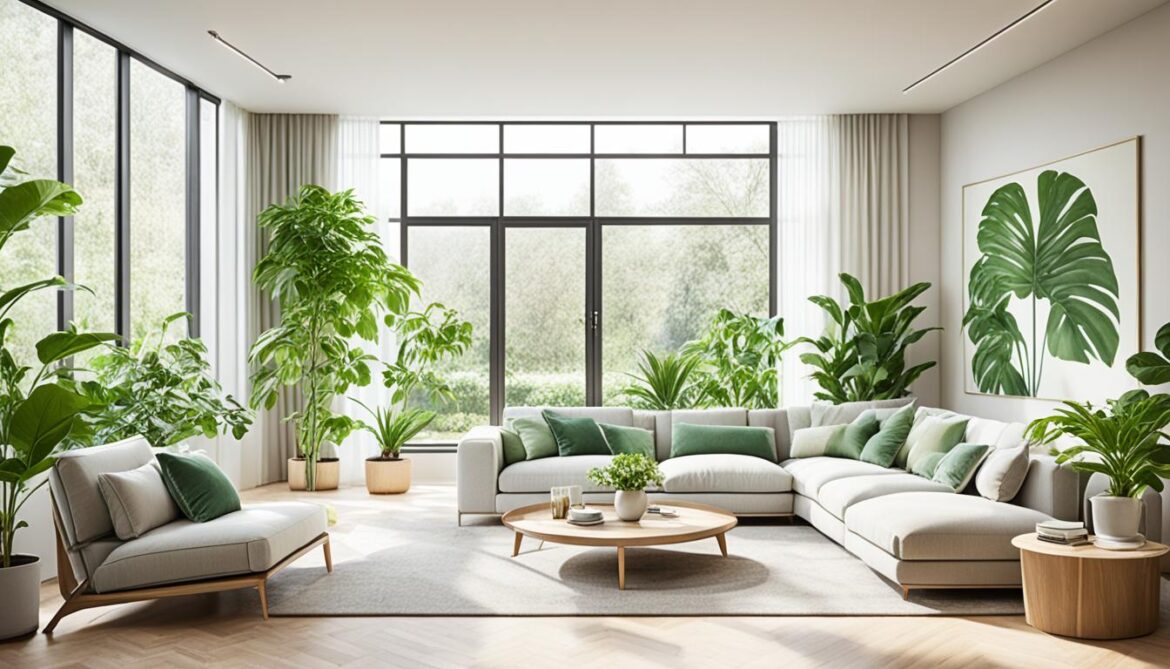
Benefits of Using Healthy Products in Green Buildings:
- Improved indoor air quality
- Reduced risk of respiratory issues
- Promotion of overall wellness
- Sustainable and regenerative built environment
- Support for global sustainability goals
The table below highlights common healthy products used in green buildings:
| Building Product | Benefits |
|---|---|
| Low-VOC Paint | – Minimizes the release of harmful chemicals – Reduces indoor air pollution |
| Bamboo Flooring | – Renewable and sustainable material – Durable and low-maintenance |
| Recycled Insulation | – Reduces waste and landfill impact – Provides effective thermal insulation |
| Non-Toxic Adhesives | – Eliminates harmful off-gassing – Ensures indoor air quality |
Verified Performance in Green Buildings
In 2021, the focus on verified performance in green buildings has intensified. Greenwashing and performative allyship are no longer acceptable, as the market demands real change and impact on climate action. Green building certifications that verify performance, such as those offered by the International Living Future Institute, are gaining prominence. These certifications ensure that buildings meet stringent sustainability criteria and actively contribute to reducing environmental impact. Investing in an ILFI certification or label demonstrates a genuine commitment to challenging the status quo and creating a sustainable future.
“Investing in an ILFI certification or label demonstrates a genuine commitment to challenging the status quo and creating a sustainable future.”
Green building certifications play a vital role in driving the adoption of sustainable building practices and rewarding those who prioritize environmental responsibility. These certifications not only provide a clear framework for sustainable development but also offer recognition and credibility to green buildings in Sierra Leone. By achieving a verified performance certification, buildings can showcase their commitment to reducing their carbon footprint and creating a greener future.
The Benefits of Verified Performance Certifications
Verified performance certifications offer several advantages for green buildings:
- Enhanced Credibility: Green buildings with verified performance certifications gain increased credibility in the industry and among stakeholders.
- Environmental Impact: These certifications ensure that buildings actively contribute to reducing the environmental impact by meeting stringent sustainability criteria.
- Cost Savings: Green buildings often have lower operational costs, such as reduced energy consumption and maintenance, leading to long-term cost savings for owners.
- Market Differentiation: With the growing demand for sustainable buildings, a verified performance certification sets a green building apart from others, providing a competitive advantage.
By focusing on verified performance and investing in green building certifications, Sierra Leone continues to promote sustainable development and create a more environmentally conscious built environment.
Comparison of Green Building Certifications
| Certification | Criteria | Benefits |
|---|---|---|
| International Living Future Institute (ILFI) | Strict criteria for energy efficiency, water conservation, and overall sustainability | – Recognized globally – Demonstrates commitment to sustainability – Access to a network of like-minded professionals |
| Leadership in Energy and Environmental Design (LEED) | Focuses on sustainability, energy efficiency, water efficiency, and indoor environmental quality | – Widely recognized and accepted – Market differentiation – Attracts environmentally conscious tenants or buyers |
| Living Building Challenge (LBC) | Mandatory requirements for energy, water, and material usage | – Highest level of sustainability certification – Encourages regenerative design and construction |
By comparing the key features and benefits of different green building certifications, developers and building owners can make informed decisions and choose the certification that best aligns with their sustainability goals.
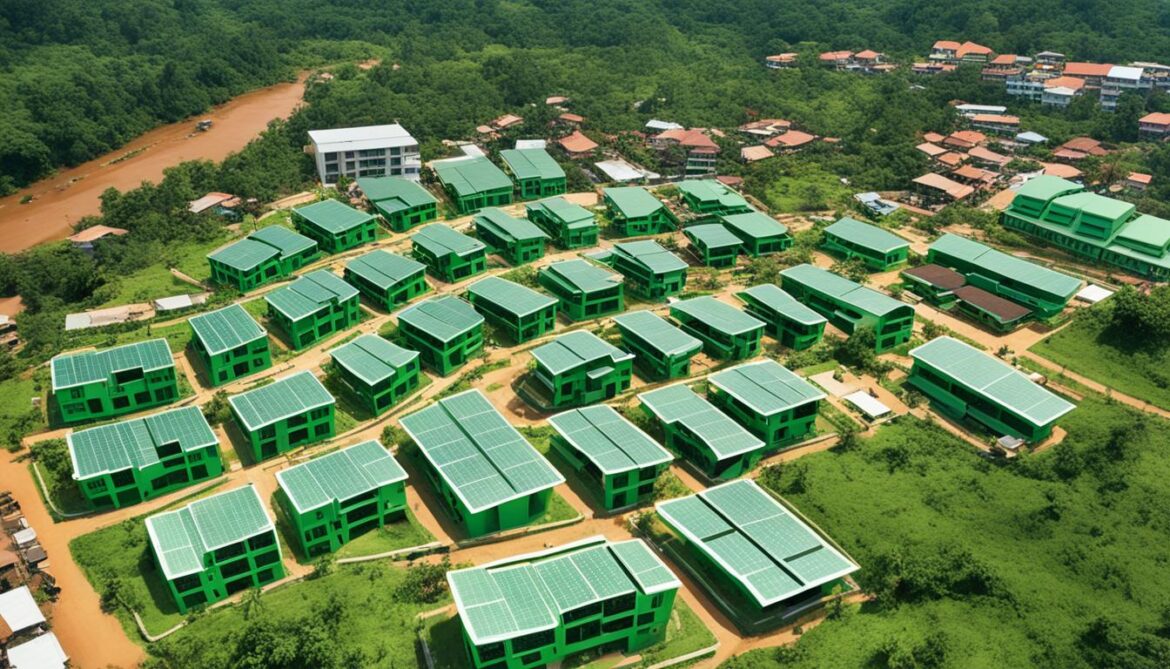
The Vision of ILFI and Living Future
The International Living Future Institute (ILFI) is dedicated to envisioning a future where all buildings and communities in Sierra Leone are regenerative and restorative. Through its Living Future Network and registered and certified projects, ILFI strives to create transformative change in the built environment, fostering sustainable practices and promoting a more sustainable and green future for Sierra Leone.
ILFI’s symbol, the dandelion, represents resilience, regeneration, and the power of collective action. Just as the dandelion’s seeds scatter and take root in new places, ILFI encourages individuals and organizations to join their mission, spreading the seeds of sustainability and making a positive impact on Sierra Leone’s built environment.
By embracing ILFI’s vision, Sierra Leone can become a leader in sustainable architecture and green building practices, setting an example for other countries to follow. Together, we can create a built environment that not only meets the needs of the present but also ensures a thriving future for generations to come.
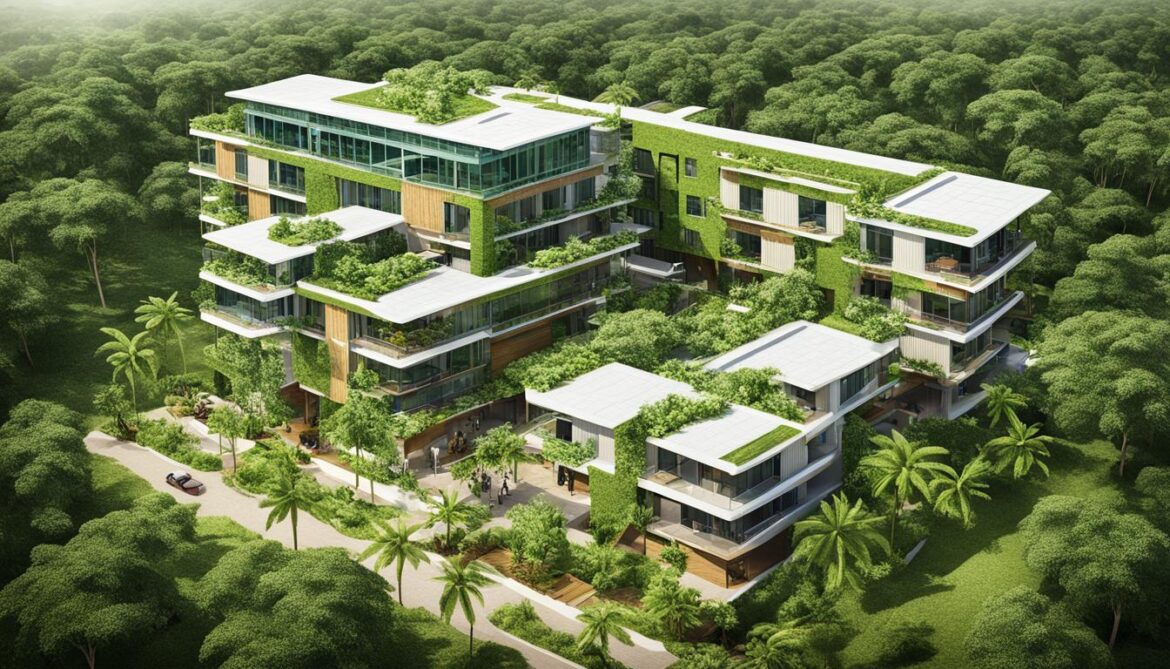
Conclusion
Sierra Leone has emerged as a leader in sustainable architecture and green building practices. The country’s commitment to eco-friendly design principles and sustainable building practices is evident in the use of pressed clay bricks and integration of renewable energy systems.
With a focus on creating a built environment that promotes well-being and reduces environmental impact, Sierra Leone has prioritized green building certifications, such as those offered by the International Living Future Institute (ILFI). These certifications drive the adoption of sustainable infrastructure development and ensure the verification of performance.
By embracing healthy products and prioritizing verified performance, Sierra Leone is building a greener future. The country’s efforts in sustainable architecture and environmentally friendly design not only create a more sustainable and resilient built environment but also contribute to global climate action.




